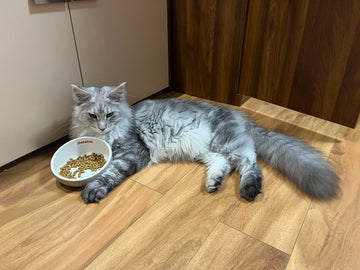Nine years, three fosters, one senior queen—and a lot of lessons. This is the cat nutrition handbook I wish I’d had at the start: plain language, no miracle powders, and practical steps you can sustain on real schedules and budgets.
1) First Principles: What “scientific feeding” really means
“Scientific” doesn’t mean complicated—it means repeatable, evidence-aligned, and kind. For cats, that boils down to four pillars:
- Protein-first, species-appropriate: obligate carnivores need high-quality animal protein and fat, not cereal fillers.
- Moisture-forward diet: cats have a low thirst drive; water in food protects urinary and overall health.
- Complete & balanced: every daily diet must cover essentials—taurine, preformed vitamin A, vitamin D, B-complex, calcium-phosphorus balance, trace minerals, arachidonic acid.
- Predictable routine: steady meal windows prevent obesity and anxiety better than “food everywhere.”
2) Label-to-bowl decoding: how to choose complete foods
Complete & balanced claims
Look for a statement that the food is “complete and balanced” for your cat’s life stage. That means the formula meets recognized nutrient profiles. If it only says “intermittent or supplemental,” it’s a topper, not a daily diet.
Dry matter math (quick and painless)
Wet food looks low in protein on the label because it’s mostly water. To compare fairly, convert to dry matter: (Protein ÷ (100 − moisture)) × 100. Aim for high protein and moderate fat on a dry-matter basis.
Ingredients & quality signals
- Named meats (“chicken,” “turkey”) over vague “meat by-product” catch-alls.
- Reasonable mineral levels (excess phosphorus isn’t ideal long-term, especially for seniors).
- Avoid “miracle” claims and powders that promise to fix everything. Balanced recipes are the fix.
3) Portions, schedules, and why free-feeding backfires
Ad-lib or “buffet” feeding sounds convenient but often leads to silent weight creep, stale kibble (saliva + heat + time), and picky habits. Scheduled meals let you count calories, watch appetite, and build training into rituals.
How much to feed (start here, then adjust)
- Start with the brand’s daily feeding guide for your cat’s weight and life stage.
- Split into 2–4 small meals. Most adult cats do well on 2–3; kittens need 3–4.
- Re-weigh weekly; adjust by 5–10% based on body-condition score (see §8).
Scheduling that sticks
- Meal-window training: offer food for 20–30 minutes, then lift the bowl. Predictability beats pleading.
- Auto-feeder, not auto-buffet: pre-program small drops to avoid the “all day nibble.”
- Pre-meal micro-training: a sit on a mat, a target touch; then place the bowl. It calms arousal and teaches manners.

4) Hydration-forward strategies (why moisture matters)
Cats evolved to get most of their water from prey. That’s why wet food is the simplest “science-based upgrade” you can make. Aim for at least one wet meal daily; fountains and broth (no onion/garlic, low salt) help, too.
- Mix a spoon of warm water into wet meals for aroma and moisture.
- Offer multiple water stations away from litter boxes.
- Broth basics: simmer plain meat/bone (no alliums), chill, skim fat. Use as a topper, not a full meal.
5) DIY the right way: safe home-cooked frameworks
Home cooking can be wonderful if it’s balanced. Cats are not small dogs; a “meat only” bowl is dangerously incomplete (missing taurine, calcium, iodine, vitamins A/D/E, B-complex balance, trace minerals). The safest route is to use a vet-formulated feline premix designed to balance boneless meat and fat. It ensures the calcium-to-phosphorus ratio, taurine safeguard, and micronutrients land in the right range.
Cooked vs raw
- Cooked: easier food-safety workflow; friendlier for households with kids/seniors.
- Raw: possible under expert guidance and strict hygiene; discuss risks and protocols with your veterinarian.
Home-cooked safety workflow
- Clean station: separate boards/knives; wash hands; sanitize surfaces.
- Cook poultry to a safe internal temperature; cool fast (shallow pans).
- Weigh portions after cooking; mix in premix as directed once cooled.
- Microbatch: freeze flat packs; defrost in the fridge, not on the counter.
DIY Cooked Cat Food — Balanced Ratio & Portion Guide
Use case: Home-cooked, boneless meat batches balanced with a feline-specific premix. Cook meats safely, cool, then mix in premix per label. Freeze in daily packs.
🧪 Target Macro & Micro Framework (as-fed after mixing)
- Protein (animal): ≥ 40–45% as-fed (≈ 55–65% dry matter)
- Fat (animal): 20–30% as-fed (adjust for body condition)
- Moisture: 40–55% (from natural juices + added warm water/broth)
- Calcium-to-Phosphorus: ~1.1–1.3 : 1 (covered by the premix)
📦 Batch Composition (Cooked, Boneless) — Per ~1.2 kg Final Food
| Component | Role | Amount | Notes |
|---|---|---|---|
| Lean/Dark Muscle Meat (chicken thigh/turkey dark, pork loin, rabbit) | Primary protein & amino acids | 900 g cooked weight | Mix 2–3 proteins across batches to diversify amino acids & flavor. |
| Taurine-rich meat (heart or dark leg meat) | Natural taurine boost | 200 g cooked | Still require premix taurine safety; heart helps but isn’t enough alone. |
| Liver (chicken/turkey) | Vitamin A & micronutrients | 50–60 g cooked | Do not exceed ~5% of the batch; vitamin A is potent. |
| Oily Fish (salmon/mackerel), optional | EPA/DHA omega-3 | 30–40 g cooked (1–2×/week) | Limit for iodine/phosphorus balance; rotate, don’t daily. |
| Animal Fat (skin on thigh or added poultry fat), as needed | Energy & palatability | 0–60 g cooked | Use to hit 20–30% as-fed fat; trim for overweight cats. |
| Warm Water/Broth (no onion/garlic, low-salt) | Moisture & aroma | 200–350 ml | Add gradually to preferred texture; improves hydration. |
| Feline Premix (vit/min/taurine) | Completes Ca:P & micros | Per label for ~1.2 kg food | Stir in after cooling; follow brand dosage precisely. |
|
Yield: ~1.2 kg finished food ≈ 10–12 days for a 4–5 kg adult (see portion guide). Food safety: Cook poultry to safe temp; cool fast (shallow pans); freeze flat; thaw in fridge. |
|||
🍽️ Daily Portion Guide (Starting Points — Adjust by Body Condition)
Most healthy indoor adults maintain on 35–45 kcal/kg body weight/day. As a quick start, feed 20–30 g/kg/day of this cooked food (as-fed), then fine-tune weekly.
| Cat Weight | Daily Portion (as-fed) | Meals/Day | Notes |
|---|---|---|---|
| 3.0 kg | 70–90 g | 2–3 | Lower end for low-activity; higher end for playful cats. |
| 4.0 kg | 90–120 g | 2–3 | Most indoor adults land here; split evenly. |
| 5.0 kg | 110–145 g | 2–3 | Trim ~10% if weight trending up; add play micro-sessions. |
| 6.0 kg | 130–170 g | 2–3 | Use kitchen scale; re-weigh cat weekly for 4 weeks. |
| Tip: Start mid-range for 7 days. If ribs are hard to feel, reduce 5–10%; if ribs too sharp or energy low, increase 5–10%. | |||
🔄 Rotation & Texture Plan
- Protein rotation: Alternate chicken/turkey ↔ rabbit/pork weekly; keep liver ≤5% of each batch.
- Texture: Many cats prefer small chunks over purée; gradual shifts (pâté → mixed → chunky) improve acceptance.
- Toppers ceiling: ≤10–15% calories from toppers (plain meat shred, warm broth) to prevent imbalance.
⚠️ Do-Not List (Common Hazards)
- Alliums (onion, garlic, chives, leeks), alcohol, caffeine, xylitol, grapes/raisins.
- Cooked bones; excessive liver; dog vitamins or non-feline premixes.
- Counter thawing; re-freezing thawed portions; unwashed bowls.
Medical disclaimer: This framework is not a substitute for veterinary advice. Kittens, seniors, and cats with medical conditions (CKD, pancreatitis, IBD, diabetes, etc.) require individualized plans from your veterinarian or a board-certified veterinary nutritionist.
6) Sample cooked recipe (balanced with a vet-formulated premix)
This example shows structure, not a one-size bowl. Always follow your premix label and your vet’s advice.
Ingredients (≈ 7 days for a 4–5 kg adult)
- 900 g boneless chicken thigh (skin on for fat)
- 250 g turkey heart or dark meat (adds taurine naturally)
- 60 g chicken liver (do not exceed; vitamin A is potent)
- 40 g salmon or mackerel (twice weekly only, for omega-3)
- Vet-formulated feline premix (dose per label for ~1.2 kg cooked meat)
- Optional: 30–50 g pumpkin purée for fiber (some cats do better with none)
- Warm water/broth to loosen texture
Method
- Poach or bake meats until safely cooked; cool quickly.
- Weigh cooked yields; chop or pulse for preferred texture (chunks beat purée for many cats).
- Whisk the premix with warm water; fold into meat evenly.
- Portion into daily packs; freeze; thaw in fridge 12–24 h before feeding.
Rotation idea: chicken/turkey week, then rabbit/pork week (lean pork, fully cooked). Keep the liver cap low across weeks.

7) Smart toppers & treat rules (without creating picky eaters)
Toppers are tools, not crutches. Keep them to ≤10–15% of daily calories so the base diet stays balanced.
- Gentle topper strategy: warm water/broth, a shred of plain meat, or a sprinkle of freeze-dried meat.
- Treat ceiling: 5–10% of daily calories; count them. “Invisible calories” are how indoor cats get round.
- Texture rotation: pâté vs shreds vs chunks can prevent “metabolic boredom” without breaking balance.
8) Weight control & body-condition scoring
Use a 9-point Body Condition Score (BCS): ribs palpable with slight fat cover, visible waist from above, belly tuck from the side. Weigh weekly on the same scale; log it. If BCS drifts up, trim portions by 5–10% and add one play micro-session (laser or wand, 3–5 minutes).
9) Life stages: kitten → adult → senior (and special cases)
Kittens
- Energy-dense, complete diets; 3–4 meals/day.
- Wet food early to lock in hydration habits.
- No calcium hacks (like bone meal) without a formula—growth plates are unforgiving.
Adults
- Two to three meals/day; keep muscle with play and protein.
- Adjust intake with weight, indoor activity, and neuter status.
Seniors
- Prefer higher moisture, easy-to-chew textures, and steady routines.
- Discuss phosphorus targets and protein quality with your vet; seniors need better protein, not none.
Pregnancy, lactation, specific medical conditions, and therapeutic diets require veterinary guidance.
10) Multi-cat households: peace at the bowl
- One bowl per cat, plus one extra. Space them so each cat feels safe.
- Feed on raised perches for shy cats; use microchip feeders for “food thieves.”
- End meals with a calm cue; then play together or offer parallel enrichment to diffuse tension.

11) Shopping & budget: spend where it counts
You don’t need a shelf of supplements. You need a reliable base diet, a few good cans, and perhaps a premix for DIY weeks. Pricey “miracle” jars are where most people donate to the marketing department.
- Buy smaller bags of dry food if you use any; freshness beats bulk savings.
- Wet food case discounts help; rotate proteins within the same trusted brand.
- Invest in a digital kitchen scale and airtight storage—two tools that actually change outcomes.
12) A 7-day transition & meal plan template
Slow is smooth, smooth is fast. Mix new with old over a week to protect the gut.
Transition Ratios
- Day 1–2: 25% new / 75% old
- Day 3–4: 50% new / 50% old
- Day 5–6: 75% new / 25% old
- Day 7: 100% new
Weekly Rhythm
- Mon–Fri: base complete food (mix wet + dry or all-wet)
- Two DIY nights: balanced cooked batches (see §6)
- Daily: one micro-play before dinner, water refresh 2×, weigh bowls
13) FAQ (collapsible)
Do cats need carbs?
Cats do not have a dietary requirement for carbohydrates, but small amounts can appear in complete foods. Focus on high animal protein, adequate fat, and moisture.
Is fish okay?
As a rotation item, yes—especially oily fish for omega-3. Avoid daily fish-only diets and keep portions modest to manage phosphorus and iodine.
Should I add “extras” like oils or powders?
If your base diet is complete and balanced, you usually don’t need add-ons. For DIY, a feline-specific premix is the safe way to cover vitamins and minerals.
My cat is a picky eater—now what?
Short meal windows, warm food slightly, try gentle toppers, and rotate textures (not random brands) to build confidence. Avoid buffet bowls.
14) Gentle links & inspiration
Feeding is care, but it’s also relationship. Many families like to make the feeding corner feel personal with quiet, non-toy décor. If you enjoy tactile, handcrafted keepsakes, you might browse custom felt plush options for a shelf (display only, not for cats). And if you’re curious why people gravitate to lifelike tributes in the first place, this essay—why custom animals—explores how tangible objects support memory and routine.
Conclusion
Science-based feeding is quieter than the internet makes it seem. Feed a complete, moisture-forward, protein-first diet. Keep portions honest and schedules steady. Use DIY when you can do it right—with a premix and a plan. Most of all, watch your actual cat: appetite, stool, coat, weight, and mood tell you when you’re getting it right. Start simple this week—one wet meal a day, bowls washed nightly, and a seven-day transition if you’re changing foods. Small, repeatable practices beat big promises every time.
Bookmark this and tweak as you learn your cat’s rhythm. That’s the science: observe, adjust, repeat.





